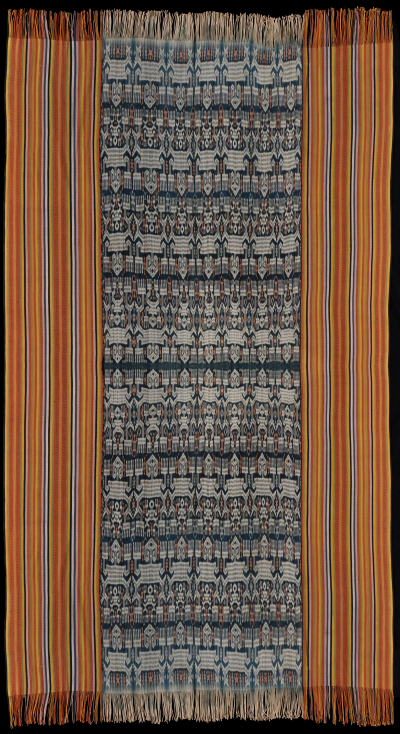| |
 
 | | | |
245 Timor, West Timor
Mau naek (men's wrap)  
| | Locale: | Amanuban | | Period: | 1930-1950 | | Yarn: | Cotton, commercial, fine, double-ply | | Technique: | Warp ikat | | Panels: | 4 | | Size: | 154 x 260 cm (5' 0" x 8' 6") LW: 1.69 | | Design: | Stacked and interlocking humanoid figures, shaped to make them froglike, 'frogmen'. Locally called katak (frog) motif, which represents the life cycle of generations. Note how the large figures, probably representing ancestors, appear to give birth to the smaller figures nestled underneath. The smaller figures in the two central bands are slightly larger than those above and below them. Very unusual is the asymmetry: three columns of motifs on the left versus four on the right. Most of the work was done on warp skeins of only eight threads, producing 'rods' on the two identical ikated panels merely two threads wide. Curiously, the style of the headdress, with the inward curl, which recalls the pilu saluf headdress of a meo warrior, is very similar to that on a Sarawak pua, 037, suggesting that this is an archaic motif with formerly wide distribution. | | Comment: | Large blanket with striking design, very well executed. Natural dyes in the ikated central panel, pre-dyed commercial yarn in the side panels. The indigo was done in two stages, producing pale and darker blue. The pinkish red shows bleeding both longitudinally and laterally, indicating an unstable vegetable dye. Slight fading of the side panels (which makes their tonality more pleasant than it must have been originally) but otherwise in immaculate state of preservation. Excellent ikating produced crisp drawing, and a distinctive sense of refinement. Clearly the work of a master weaver. Ex collection August Flick. [Its large size preventing photography of the entire whole cloth, the image is composed of two mirroring halves - closely matching reality.] | | Background: | Chapters on Timor and West Timor. | | Exhibited: | Hong Kong University Museum and Art Gallery, 2017.
Timor: Totems and Tokens, Museu do Oriente, Lisbon, 2019/20. | | Published: | Ikat Textiles of the Indonesian Archipelago, 2018.
Timor: Totems and Tokens, 2019.
Ikat Textiles of Timor: Indonesian and Timor-Leste, 2025. | | Compare: | 112 159 181 182 | | Sources: | The heads of the figures are very similar to those on PC 244, which Cinatti, in Motivos Artisticos Timorenses e a sua Integreção, identifies as crocodiles - on Timor generally regarded as belonging in the people's ancestral chai | | |

©Peter ten Hoopen, 2025
All rights reserved.
|
|


